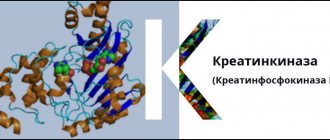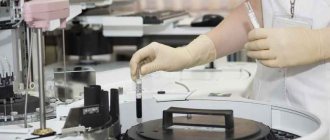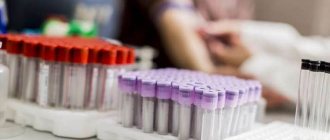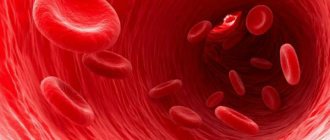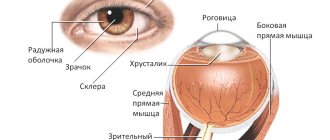An important indicator of a biochemical blood test is creatinine. This amino acid is formed in muscles after the non-enzymatic breakdown of creatine, a substance involved in the energy metabolism of the muscular system. The concentration of creatinine in the blood, with proper functioning of the muscular system and kidneys, is always maintained within certain values.
Deviations from the norm indicate a violation of the process of elimination from the body. The problem arises with kidney pathologies and impaired energy metabolism in the muscles. Understanding what creatinine is in the blood, the doctor can prescribe additional tests to make an accurate diagnosis in order to carry out the correct treatment.
Complexes with this research
Entry into IVF Examination when a woman enters the IVF procedure 13,590 ₽ Composition
Women's check-up No. 1 38 studies for an annual preventive examination 11,260 ₽ Composition
Biochemistry of blood. 8 indicators Minimum biochemical blood test 990 ₽ Composition
IN OTHER COMPLEXES
- Female infertility RUB 9,210
- Healthy interest RUB 2,140
- Fitness control of sports nutrition RUB 2,780
- Nutritionist recommends RUB 4,190
- Kidneys. Extended examination 1,050 ₽
Indications for the study
Most often, a blood test for creatinine is prescribed if kidney problems are suspected. Also, its results are used to assess the condition of the entire urinary system as a whole. The study is prescribed if drug therapy is planned that poses a potential danger to the kidneys. Healthy people who actively engage in sports and build muscle volume also need to monitor their performance. This is also important for those who follow a protein diet. The analysis can be prescribed during a preventive examination or diagnosis of diseases, independently or in combination with other studies.
Detailed description of the study
The kidneys constantly filter the blood and remove substances formed during metabolism from the body. One of these substances is creatinine.
Creatinine is a metabolite that is formed by the breakdown of the amino acid creatine. It is produced in muscles during their work. By its structure, creatinine is a small molecule, which allows it to be almost completely excreted by the kidneys. Due to constant filtration and excretion, plasma creatinine levels remain relatively constant.
If kidney function is impaired, filtration worsens and the level of creatinine in the blood increases and in the urine decreases. A change in the level of creatinine in the blood plasma may indicate the presence of kidney pathology. These include: acute and chronic glomerulonephritis, pyelonephritis, kidney damage due to diabetes mellitus, arterial hypertension, urolithiasis, amyloidosis.
Changes in creatinine levels may also indicate problems with other organs. Muscle damage, including from trauma or extensive burns, causes an increase in the concentration of creatinine in the blood. A similar situation is observed against the background of starvation and infectious diseases. In this case, the body can use muscle protein as an energy source. With hyperfunction of the thyroid gland, the level of this indicator in the blood also increases.
However, the creatinine level has clinical significance due to the possibility of assessing renal function based on this indicator. Impaired filtration capacity of the kidneys can be asymptomatic for a long time. Therefore, laboratory tests aimed at determining the content of creatinine and urea in the blood are the most important markers of the presence of renal pathology.
The progression of kidney disease is manifested by the following symptoms:
- The appearance of general weakness;
- Problems with urination;
- Decreased appetite and weight;
- Lower back pain;
- Increased blood pressure.
The body's production of creatinine depends primarily on the absolute amount of muscle mass, which is why the normal level of creatinine in children is lower than in adults, and in women it is lower than in men. Also, its level may increase slightly after heavy physical exertion.
Thus, analysis of creatinine levels allows one to suspect renal dysfunction. For a more detailed assessment of the pathology, additional research is necessary on its concentration in daily urine, as well as the content of albumin and urea in the body.
When is it necessary to take a creatinine test before a CT scan with contrast?
Analysis is not required if:
- The patient's age is less than 60 years;
- There is no history of kidney disease or organ surgery;
- There is no history of diabetes mellitus;
- There is no history of gout;
- There is no history of arterial hypertension.
In other cases, there is a high risk of contrast intolerance, up to anaphylactic shock.
You can clarify the advisability of a blood test for creatinine before a CT scan with contrast during a consultation with your doctor or by calling our center’s helpline.
References
- Clinical protocol for diagnosis and treatment of acute renal failure, 2014. - 24 p.
- Kucher, A.G., Kayukov, I.G., Yesayan, A.M. and others. The influence of the quantity and quality of protein in the diet on kidney activity. Nephrology, 2004. - Vol. 8(2). — P. 14‐34.
- KDIGO practice guidelines for the diagnosis, prevention and treatment of mineral and bone disorders in chronic kidney disease (CKD-MBD). Summary of recommendations. Nephrology, 2011. - T. 15(1). — P. 88‐95
- Nephrology. National leadership / ed. ON THE. Mukhina. - M.: GEOTAR-Media, 2009. - 720 p.
General information
Creatinine takes part in the energy supply cycle for muscles. It is formed in constant quantities and is excreted by the kidneys. The level of creatinine can be used to judge the functioning of the kidneys. It must be taken into account that indicators begin to deviate from the norm only after glomerular filtration decreases to critical values.
Creatinine is a more sensitive indicator of kidney health than urea, but this indicator alone is not enough for diagnosis. There are a large number of factors that influence test results. Kidney problems can be suspected if the patient has symptoms such as swelling, change in urine color, pain in the lumbar region, or burning sensation when urinating. Kidney disease affects your general well-being in the following ways: fatigue, high blood pressure, sleep disturbance, loss of appetite.
How is diagnostics carried out?
To get the most reliable result, you need to properly prepare for the procedure. To do this, experts recommend following a few simple recommendations:
- avoid increased physical activity for a few days;
- the day before the session, refrain from eating large amounts of protein foods (a maximum of 200 grams of meat or fish is allowed);
- Avoid smoking and drinking alcohol;
- drink a lot of clean water.
If the patient is taking any medications, this should be reported to the attending physician. The specialist may recommend temporarily stopping the drug or take this factor into account when interpreting the data obtained.
Blood, serum, or urine can be used to test the enzyme concentration in the blood fluid. It is recommended to carry out the procedure in the morning on an empty stomach.
The sample is taken from a vein.
Urinalysis is a little more difficult to perform because it relies on measurements of the average daily value and clearance. The latter is based on the ability of the kidneys to clear creatinine from the blood.
In this case, urine collection is required throughout the day. The liquid is then sent in small quantities to a laboratory for testing.
It is also important that the urine container is clean and sterile. Collection begins after waking up, but the first urine is skipped.
A dark, cool place is used to store collected urine. It is important not to neglect the rules of hygiene. If dirt or foreign liquid gets into the container, you are more likely to get skewed results.
Only a specialist should interpret this information.
It is important to consider the patient's general condition, age and gender, physical activity and other factors that may affect creatinine levels.
What is creatinine?
Creatine
is an amino acid produced naturally in the body and obtained in small quantities from food. Creatine has gained popularity as a dietary supplement following evidence that it can increase body weight, improve physical endurance and speed recovery. When creatine is broken down, it is used for energy and creatinine remains as waste products. Creatinine levels vary depending on factors such as height, age, or gender, so there is no standard value.
Norm
The final blood content is expressed as a constant value. If a decrease in value is observed, this indicates some pathologies associated with hormonal imbalances, changes in weight or diet.
As a rule, creatinine levels in women are always underestimated compared to those in men. This is due to different muscle mass.
Normal values for women are presented in the table below.
Normal value, µmol/l
The male half of the population has the following values:
Normal value, µmol/l
Treatment
Low creatinine levels can indicate a variety of medical conditions, so your doctor will use the test results to determine underlying problems. If low creatinine levels, along with other symptoms, indicate liver disease, treatment most likely begins with medications and lifestyle changes. These changes may include eating healthier and avoiding alcohol.
If a person has a muscle disorder, treatment may include exercise therapy, medications, or surgery.
What can affect the result?
Creatinine levels decrease in pregnant women and the elderly.
Important! Some patients with chronic renal failure take the test and receive results within the reference values. For this reason, such a study is not always advisable if carried out without additional tests.
Important! The interpretation of the analysis is carried out only by a doctor. If necessary, the patient is referred for other examinations (including instrumental and functional).
We recommend that you consult your doctor and get a check-up.
Role and functions
Creatinine is the main indicator of kidney activity. Determining its concentration as a component of blood fluid is necessary to assess the rate of protein metabolism in the human body. In addition, this value shows how quickly creatinine is excreted by the kidneys.
When proteins and amino acids are broken down, the body releases byproducts, not the least of which is creatinine. Creatine is found in muscle mass and helps provide it with the energy it needs to function properly.
In most cases, this substance is eliminated during:
- digestion of food in the duodenum and stomach;
- physical effort.
When the protein is broken down, the enzyme travels from the bloodstream to the kidneys, where it is filtered and excreted in the urine.
The amount of creatinine in blood fluid indicates the rate of protein breakdown. A reduced concentration of this substance may indicate the development of many pathological processes in the early stages of formation. This breakdown product negatively affects muscle function.
Additional Research
To make an accurate diagnosis and prescribe treatment, the patient may also be referred for the following studies:
- General urine analysis with microscopy
- Rehberg's test
Important indicators identified during diagnosis are also:
- Uric acid in 24-hour urine and serum
- Albumen
- Urea
- Creatinine in daily urine
- Serum sodium, calcium, potassium, phosphorus and chlorine
- Phosphorus, calcium, potassium, sodium in daily urine
What does a low creatinine level mean?
Low creatinine levels may indicate a problem with the muscles or liver, but can be caused by something less serious, such as loss of muscle mass in older people, or pregnancy.
Creatinine is always present in the bloodstream, from where it is removed by the kidneys and excreted from the body in urine. Research shows that creatinine helps fight disease and stops the growth of bacteria. A laboratory test used by doctors shows how well the kidneys remove creatinine from the body.
There are four main causes of low creatinine:
- low muscle mass;
- liver diseases;
- diet;
- pregnancy.
Low muscle mass
Creatinine levels are often related to muscle mass, which can decrease with age or illness. A low level may indicate that muscle mass is reduced, such as in muscular dystrophy. Older people often lose muscle mass as they age, and this is not usually a serious medical problem.
Liver problems
Creatine is produced by the liver, and an unhealthy liver will not be able to produce normal amounts of creatine. Chronic liver disease can cause a 50% reduction in creatine production. This means there will be a low level of creatinine in the blood, which can be checked by a blood test.
Diet
Although creatine is produced naturally, small amounts come from food, so diet may influence low creatinine levels. Creatine is primarily found in meat, so people who follow a vegetarian or low-protein diet tend to have low creatinine levels.
Pregnancy
Pregnancy often causes low creatinine levels, which will return to normal after childbirth.
Symptoms of low creatinine levels
Symptoms of low creatinine depend on the underlying condition, but may include:
- With low muscle mass
- weakness, difficulty performing physical exercises; - With liver disease
- weakness, pain in the upper right corner of the abdomen, nausea; - When dieting
- weakness or dizziness, weight loss.
In most cases, symptoms do not indicate low creatinine levels, but may indicate other health problems.
